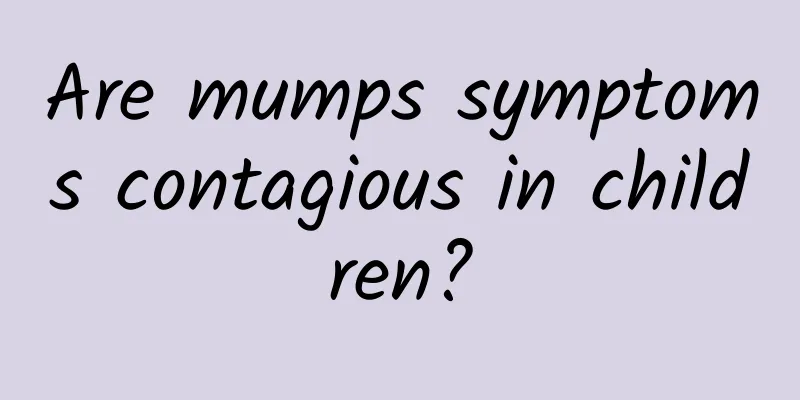Why do newborn babies have jaundice?

|
The cause of jaundice in newborn babies is usually related to their incomplete liver development, a large number of red blood cells, and the special metabolism of bilirubin. It may also be affected by environmental factors, incompatibility of maternal and fetal blood types, or certain diseases. Parents need to seek medical attention and receive professional evaluation in time according to the type and severity of jaundice to ensure proper treatment. 1. Genetic factors Some neonatal jaundice may be related to genetics. For example, if parents have a history of hereditary hemolytic diseases such as G6PD deficiency, the child is prone to jaundice due to high bilirubin. If there are metabolic-related genetic diseases in the family, such as Gilbert syndrome, it may also lead to bilirubin avoidance disorders and aggravate jaundice. For such problems, parents should inform the genetic history as early as possible for early detection and intervention. 2 Environmental factors Some external factors can also affect the occurrence of jaundice. For example, premature babies will have a significantly higher incidence of jaundice due to insufficient physiological function development after the mother's premature delivery. If breastfeeding is not timely after birth, the supply of albumin that binds to bilirubin will be reduced due to insufficient feeding, which may lead to aggravated jaundice. Parents are advised to pay attention to timely nutrition for newborns according to the doctor's advice to promote metabolism. 3 Physiological factors The liver of newborns is not fully developed yet, which is the physiological cause of most jaundice. In the first few days after birth, the excretion of bilirubin still needs time to adapt, and excessive bilirubin easily accumulates in the blood and causes jaundice. This type of jaundice gradually improves with the development of the liver in most full-term infants, and parents do not need to worry too much, but they must pay attention to monitoring color changes. 4. Incompatibility of blood types between mother and baby If the mother and baby have incompatible blood types, such as the mother is type O and the baby is type A or B, hemolytic jaundice may occur. Since a large amount of bilirubin is released when red blood cells are dissolved, this type of jaundice usually appears earlier and is darker in color, and may be accompanied by anemia and other symptoms. Treatment can be achieved by controlling the bilirubin level in the blood through phototherapy, exchange transfusion therapy, etc. 5 Pathological causes If neonatal jaundice lasts for a long time or is dark in color, you should be alert to pathological causes, such as neonatal sepsis, biliary atresia, hypothyroidism, etc. Pathological jaundice usually requires a clear diagnosis through blood tests, imaging tests, etc., and targeted measures are taken according to the cause, such as anti-infective drug treatment, surgical treatment or hormone intervention. When a newborn baby develops jaundice, parents should first observe whether the jaundice persists, develops or worsens, or is accompanied by other symptoms. Mild physiological jaundice usually subsides on its own, but if the jaundice in the newborn baby does not subside or deepens in color after more than 2 weeks, seek medical attention immediately. Scientific monitoring and intervention can effectively protect the health of newborn babies, and parents need to actively cooperate with the doctor's treatment plan and care recommendations. |
<<: Is hand, foot and mouth disease in young children highly contagious?
>>: Do children need surgery for hernia?
Recommend
What to do if your child has a cough
Children are the treasures of parents. If there i...
The efficacy of Baby Baifukang Ointment
Baifukang Ointment is made of many kinds of plant...
Should children with yellow phlegm be treated? What should children with yellow phlegm be treated?
If you cough with yellow sputum, you need to find...
Is mumps contagious?
Mumps is an infectious disease caused by the mump...
Is indigestion harmful to babies? How can babies improve indigestion by eating?
Indigestion can cause diarrhea, even abdominal pa...
The best specialist hospital for pediatric diarrhea
Autumn and winter are the peak seasons for diarrh...
What are the symptoms of cough and pneumonia in children? Will cough and pneumonia in children lead to mental abnormalities?
Children are sometimes invaded by some diseases d...
What are the symptoms of vulvar dystrophy? What are the most typical manifestations of vulvar dystrophy?
The symptoms of vulvar itching caused by vulvar m...
Traditional Chinese Medicine Treatment for Diarrhea in Children
We all know that Chinese medicine treats the root...
What virus causes diarrhea in children in summer
Children's diarrhea in summer is often caused...
What is conditional pathogenicity?
Conditional pathogenicity refers to the phenomeno...
Medication for herpetic pharyngitis and hand, foot and mouth disease in children
Herpetic pharyngitis and hand, foot and mouth dis...
What are the precautions for acute laryngitis in children?
What are the precautions for acute laryngitis in ...
What are the triggering factors of pneumonia in children?
Pneumonia in children is mainly caused by infecti...
Massage treatment for polio
Polio is an acute infectious disease caused by a ...









